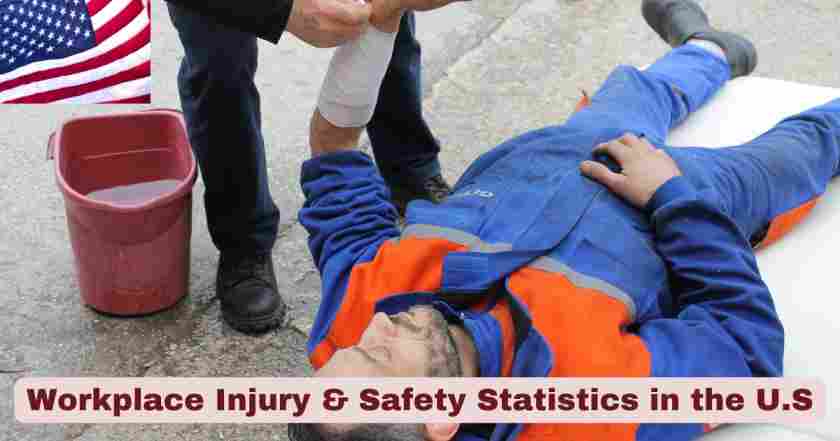Workplace Safety & Injury in the U.S. in 2025
The landscape of workplace safety in the United States continues to evolve, with 2023 marking a historic milestone in occupational safety records. According to the latest data from the Bureau of Labor Statistics, American workplaces experienced their lowest total recordable case rate in over two decades, signaling significant improvements in workplace safety protocols and employer awareness. This remarkable achievement comes at a time when the nation’s workforce remains diverse and dynamic, spanning across industries that range from traditional manufacturing to emerging technology sectors.
Despite these encouraging trends, workplace injuries and illnesses continue to impact millions of American workers annually. The most recent comprehensive data reveals that private industry employers reported 2.6 million nonfatal workplace injuries and illnesses in 2023, representing a substantial decrease from previous years. Understanding these statistics is crucial for employers, safety professionals, and policymakers as they work together to create safer work environments and protect the well-being of the American workforce across all sectors of the economy.
Workplace Injury Facts in the U.S. 2023
| Workplace Safety Metric | 2023 Data | Previous Year |
|---|---|---|
| Total Recordable Cases | 2.6 million | 2.8 million (2022) |
| Total Recordable Case Rate | 2.4 per 100 FTE workers | 2.7 per 100 FTE workers (2022) |
| Fatal Work Injuries | 5,283 deaths | 5,486 deaths (2022) |
| Fatal Work Injury Rate | 3.5 per 100,000 FTE workers | 3.7 per 100,000 FTE workers (2022) |
| Days Away From Work Cases | 946,500 cases | 1.2 million cases (2022) |
| Worker Deaths Every | 99 minutes | 96 minutes (2022) |
| Most Dangerous Industry | Transportation & Warehousing | 12.9 fatal injuries per 100,000 FTE |
| Leading Cause of Death | Transportation Incidents | 36.8% of all fatalities |
| Workplace Violence Deaths | 740 total | 458 homicides |
Workplace injury statistics in the U.S. for 2023 show a slight improvement in overall safety outcomes compared to the previous year, but critical concerns remain. The total number of recordable workplace injury cases declined to 2.6 million from 2.8 million in 2022, with the recordable case rate falling to 2.4 per 100 full-time equivalent (FTE) workers, down from 2.7 per 100 FTE. This positive trend suggests that safety initiatives and regulatory enforcement may be having a measurable impact on non-fatal injuries. Similarly, days away from work cases dropped to 946,500 from 1.2 million, indicating a notable reduction in serious injuries requiring extended recovery. Despite these improvements, 5,283 workers still lost their lives on the job in 2023—a tragic reminder of the persistent risks in high-hazard industries.
Fatal injuries remain a sobering aspect of workplace safety, although the data shows a slight reduction. The fatal work injury rate declined from 3.7 to 3.5 per 100,000 FTE workers, while the average time between worker deaths increased slightly to every 99 minutes, up from 96 minutes in 2022. The most dangerous sector continues to be Transportation and Warehousing, with a staggering 12.9 fatal injuries per 100,000 FTE workers, reinforcing its status as the deadliest industry in the U.S. Transportation incidents were the leading cause of fatal injuries, accounting for 36.8% of all deaths. Alarmingly, 740 deaths were attributed to workplace violence, including 458 homicides, emphasizing the growing need for robust workplace violence prevention strategies. These figures highlight that while overall safety may be improving, targeted interventions are still urgently needed to protect workers in high-risk environments.
Workplace Injury Statistics in the U.S. 2023
Total Recordable Cases in the U.S. 2023
| Industry Sector | Total Cases | Rate per 100 FTE Workers | Change from 2022 |
|---|---|---|---|
| Health Care & Social Assistance | 562,500 | 3.6 | Down from 665,300 |
| Manufacturing | 355,800 | 2.8 | Down from 396,800 |
| Retail Trade | 353,900 | 3.1 | Down by 68,800 |
| Transportation & Warehousing | 265,700 | 4.5 | Decreased from 2022 |
| Food Manufacturing | 61,400 | 3.6 | Down from 4.6 rate |
| Couriers & Messengers | 77,000 | 9.2 | 29% of transport sector |
The 2023 workplace injury data represents a watershed moment for occupational safety in the United States. The total recordable case rate of 2.4 per 100 full-time equivalent workers marked the lowest rate in the data series dating back to 2003, demonstrating the effectiveness of enhanced safety protocols and increased employer awareness. This significant improvement was particularly notable in the health care and social assistance sector, which saw cases drop from 665,300 in 2022 to 562,500 in 2023, representing a substantial reduction in workplace incidents.
The manufacturing sector also experienced meaningful improvements, with total cases declining from 396,800 in 2022 to 355,800 in 2023. This reduction coincided with a decrease in the incident rate from previous years, suggesting that manufacturers are successfully implementing more effective safety measures and training programs. The retail trade sector showed similar positive trends, with cases falling by 68,800 from 2022 levels, indicating that customer-facing industries are also prioritizing worker safety despite the challenges of public interaction and varied work environments.
Fatal Workplace Injuries in the U.S. 2023
| Fatal Injury Category | 2023 Statistics | Percentage of Total | Rate per 100,000 FTE |
|---|---|---|---|
| Transportation Incidents | 1,942 deaths | 36.8% | Leading cause |
| Falls, Slips, and Trips | 421 in construction | 39.2% of construction deaths | Construction-specific |
| Violent Acts | 740 total | 14.0% | 458 homicides |
| Construction Industry | 1,075 deaths | 20.3% | Highest sector count |
| Transportation & Warehousing | 930 deaths | 17.6% | 12.9 per 100,000 FTE |
| Opioid-Related Deaths | 162 primary | 3.1% | 144 additional contributor |
The fatal workplace injury statistics for 2023 reveal both progress and ongoing challenges in occupational safety. With 5,283 fatal work injuries recorded nationwide, the United States experienced a 3.7% decrease from the 5,486 fatalities in 2022. This improvement translated to a worker dying every 99 minutes from a work-related injury, compared to every 96 minutes in 2022. The fatal work injury rate of 3.5 fatalities per 100,000 full-time equivalent workers represented a meaningful reduction from the 3.7 rate in 2022.
Transportation incidents remained the leading cause of workplace fatalities, accounting for 36.8% of all occupational deaths in 2023. This category encompasses a broad range of scenarios, from roadway collisions involving commercial drivers to workplace vehicle accidents across various industries. The construction industry continued to face significant challenges, recording 1,075 fatalities in 2023, marking the highest count for this sector since 2011. Within construction, falls, slips, and trips accounted for 39.2% of all construction fatalities, with most fatal falls occurring from heights between 6 and 30 feet.
Days Away From Work Cases in the U.S. 2023
| DAFW Case Type | 2023 Numbers | Rate per 100 FTE | Percentage of DART |
|---|---|---|---|
| Total DAFW Cases | 946,500 | 0.9 | 62.0% |
| Days of Job Transfer/Restriction | 581,000 | 0.6 | 38.0% |
| Sprains, Strains, Tears | 547,980 | Historical data | Leading injury type |
| Back Injuries | 250,830 | Historical data | Major concern |
| Median Days Away | 10 days | 2022 data | Recovery time |
| Healthcare Worker Cases | Increased | Variable | Notable sector |
The days away from work (DAFW) cases in 2023 totaled 946,500, representing a 20.1% decrease from 2022 levels. These cases occurred at a rate of 0.9 cases per 100 full-time equivalent workers, down from 1.2 in 2022, indicating that when injuries do occur, they are becoming less severe on average. The DAFW cases represented 62% of all cases involving days away from work, job restriction, or transfer, demonstrating that the majority of workplace injuries requiring time off work are serious enough to prevent workers from performing their regular duties.
Days of job transfer or restriction (DJTR) cases accounted for 581,000 incidents in 2023, representing 38% of total DART cases and occurring at a rate of 0.6 cases per 100 FTE workers. This category reflects injuries that, while serious enough to require modified work arrangements, allow workers to remain productive in alternative capacities. The historical data shows that sprains, strains, and tears continue to be the leading types of workplace injuries, with 547,980 cases recorded in recent years, while back injuries remain a significant concern with 250,830 cases affecting American workers.
Industry-Specific Workplace Injuries in the U.S. 2023
| High-Risk Industries | Total Cases | Fatality Rate | Key Risk Factors |
|---|---|---|---|
| Transportation & Warehousing | 265,700 cases | 12.9 per 100,000 FTE | Vehicle operations, loading |
| Health Care & Social Assistance | 562,500 cases | 3.6 per 100 FTE | Patient handling, violence |
| Construction | 1,075 deaths | Highest fatality count | Falls, equipment |
| Manufacturing | 355,800 cases | 2.8 per 100 FTE | Machinery, repetitive motion |
| Retail Trade | 353,900 cases | 3.1 per 100 FTE | Customer violence, lifting |
| Administrative & Support Services | 484 deaths | Variable | Landscaping, tree work |
The industry-specific data for 2023 reveals distinct patterns of workplace risk across different sectors of the American economy. The transportation and warehousing sector faced particularly significant challenges, with 265,700 total cases and a fatal injury rate of 12.9 per 100,000 full-time equivalent workers. This sector experienced 930 fatalities in 2023, though this represented an 11.7% decrease from the 1,053 fatalities recorded in 2022. Transportation incidents accounted for 71.7% of fatalities within this sector, with roadway collisions being the primary cause of death.
The health care and social assistance industry demonstrated significant improvement in 2023, with 562,500 cases down from 665,300 in 2022. Despite this improvement, the sector maintained a total recordable case rate of 3.6 per 100 full-time equivalent workers, reflecting the ongoing challenges healthcare workers face from patient handling injuries, workplace violence, and exposure to occupational hazards. The construction industry continued to face substantial safety challenges, recording 1,075 fatalities in 2023, the highest count since 2011, with falls, slips, and trips accounting for 39.2% of all construction deaths.
Workplace Violence Statistics in the U.S. 2023
| Violence Category | 2023 Data | Demographics | Industry Impact |
|---|---|---|---|
| Total Violent Acts | 740 deaths | 14.0% of all fatalities | Cross-industry issue |
| Homicides | 458 deaths | 61.9% of violent acts | Leading violence type |
| Retail Trade Homicides | 94 deaths | 30% of retail fatalities | Customer-facing risk |
| Women Homicide Victims | 84 deaths | 18.3% of homicides | Gender-specific data |
| Workers 25-34 Violence | 179 deaths | 121 homicides, 58 suicides | Age demographic |
| Healthcare Violence | Variable | Increasing trend | Patient interaction |
Workplace violence statistics for 2023 highlight a persistent and concerning aspect of occupational safety in the United States. Violent acts totaled 740 deaths in 2023, representing 14% of all workplace fatalities. Of these violent incidents, homicides accounted for 458 deaths, comprising 61.9% of violent acts and 8.7% of all work-related fatalities. This data underscores the reality that workplace violence extends beyond traditional industrial accidents to include intentional harm in various work environments.
The retail trade industry faced particular challenges with workplace violence, experiencing 94 homicides in 2023, which represented approximately 30% of all fatalities in this sector. This statistic reflects the vulnerability of retail workers who interact with the public and may be exposed to robbery attempts, customer disputes, and other forms of violence. Women accounted for 18.3% of homicide victims in workplace settings, though they represented only 8.5% of all workplace fatalities, indicating that when women experience fatal workplace injuries, they are disproportionately likely to be victims of violence rather than accidents.
Demographic Patterns in Workplace Injuries in the U.S. 2023
| Demographic Group | Key Statistics | Primary Risks | Industry Concentration |
|---|---|---|---|
| Workers 55-64 | 1,089 deaths | Transportation, falls | 20.6% of total fatalities |
| Hispanic/Latino Workers | 1,250 deaths | Transportation, construction | 4.4 per 100,000 FTE |
| Black/African American Workers | 659 deaths | Transportation incidents | 3.6 per 100,000 FTE |
| Foreign-born Hispanic Workers | 839 deaths | Construction sector | 67.1% of Hispanic fatalities |
| Women Workers | 447 deaths | Healthcare, retail | 8.5% of total fatalities |
| Workers 25-34 | 179 violence deaths | Various industries | Highest violence risk |
The demographic analysis of workplace injuries in 2023 reveals important patterns that inform targeted safety interventions. Workers ages 55 to 64 continued to have the highest number of fatalities with 1,089 deaths, representing 20.6% of total fatalities. For this age group, transportation incidents were the leading cause of death with 401 fatalities, followed by falls, slips, and trips with 226 deaths. This pattern suggests that older workers may face increased risks due to factors such as slower reaction times, decreased physical resilience, or greater likelihood of working in high-risk occupations.
Hispanic and Latino workers experienced 1,250 workplace deaths in 2023, with a fatal injury rate of 4.4 per 100,000 full-time equivalent workers, representing a decrease from the 4.6 rate in 2022. Transportation incidents were the highest cause of fatalities for this demographic, with the construction industry accounting for 410 deaths among Hispanic and Latino workers. Notably, foreign-born Hispanic and Latino workers comprised 67.1% of all Hispanic and Latino worker fatalities, with construction industry deaths accounting for 37.5% of the 839 foreign-born Hispanic and Latino worker deaths.
Emerging Trends in Workplace Safety in the U.S. 2023
| Safety Trend | 2023 Impact | Statistical Evidence | Future Implications |
|---|---|---|---|
| Respiratory Illness Reduction | 72.6% decrease | 100,200 cases in 2023 | Post-pandemic recovery |
| Total Recordable Case Rate | Historic low | 2.4 per 100 FTE workers | Improved safety protocols |
| Opioid-Related Deaths | 162 primary | 144 additional contributor | Substance abuse concern |
| Technology Integration | Emerging | Data-driven safety | Prevention focus |
| Mental Health Awareness | Increasing | Violence prevention | Holistic approach |
| Industry-Specific Programs | Targeted | Sector-specific reduction | Customized interventions |
The emerging trends in workplace safety for 2023 demonstrate both the progress achieved and the evolving nature of occupational hazards. The 72.6% decrease in respiratory illness cases to 100,200 cases in 2023 represents a significant recovery from pandemic-era levels, indicating that workplace health protocols implemented during COVID-19 have had lasting positive effects. The total recordable case rate of 2.4 per 100 full-time equivalent workers marked a historic low, suggesting that comprehensive safety programs and increased employer awareness are producing measurable results.
Opioid-related workplace deaths emerged as a concerning trend, with 162 fatalities where opioids were the primary cause and an additional 144 fatalities where multiple drugs including opioids were involved. This statistic highlights the intersection of the national opioid crisis with workplace safety, suggesting that employers and safety professionals need to address substance abuse issues as part of comprehensive workplace safety programs. The integration of technology-driven safety solutions and data analytics is becoming increasingly common, allowing employers to predict and prevent workplace incidents more effectively than traditional reactive approaches.
Disclaimer: The data research report we present here is based on information found from various sources. We are not liable for any financial loss, errors, or damages of any kind that may result from the use of the information herein. We acknowledge that though we try to report accurately, we cannot verify the absolute facts of everything that has been represented.







